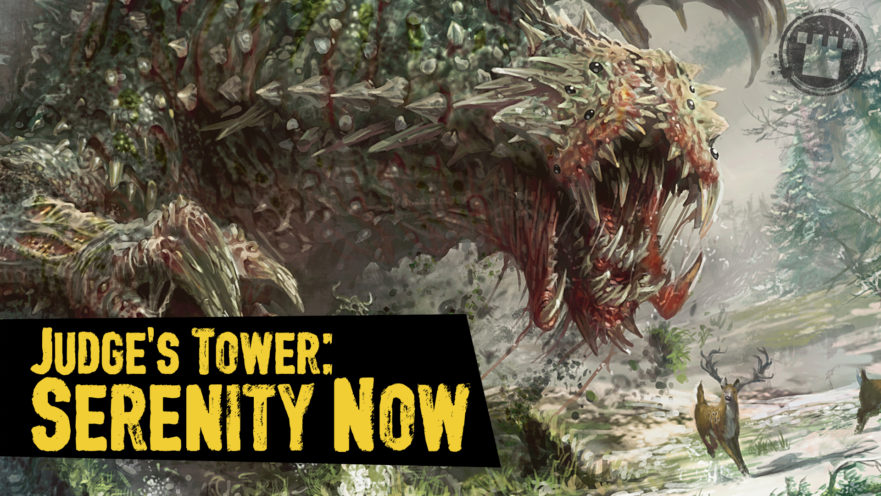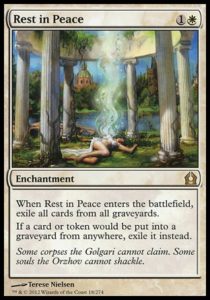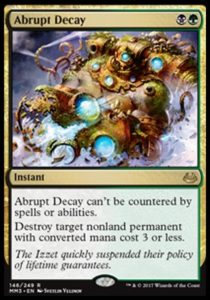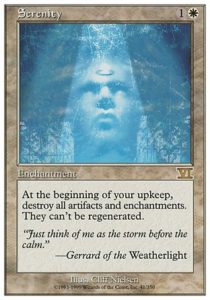Hello, and welcome to the Judge’s Tower! Judge’s Tower is a Magic format for self-deprecating people (more info about which can be found here: http://judgetower.pdxmtg.com/), the point of which is that everything you do must be done absolutely correctly within the rules; the only way to lose is the get something wrong.
I’m Chris, a Level 2 judge at Mox Boarding House Seattle, and on the way to L2, I lost a lot of games of Judge’s Tower. The Comprehensive Rules are pretty labyrinthine and daunting, and there’s a lot of room for error. I’m here to give you a bit of guidance by highlighting some of the corner cases and weird interactions that come up from time to time. Knowing the rules is necessary for a judge, but I also became a much better player over time just by knowing the ins and outs of how the game works.
So to start, we’ll look at a couple scenarios that have come up in Modern and Legacy events that I’ve judged, both revolving around one of the premier graveyard hate cards ever printed: Rest in Peace.
SCENARIO 1:
Aaron is playing Nathan in a Legacy match. It’s been a long, grindy game, but Nathan is on the ropes at one life. Aaron controls a lone Tarmogoyf, but Nathan has a Rest in Peace in play, so the Goyf isn’t really able to do much. Aaron needs to find a way to win, because Nathan spent his turn finding and casting a Helm of Obedience. He didn’t have the mana to activate it yet, but if he untaps, it’s lights out for Aaron.
Aaron untaps and draws for his turn. He slams Abrupt Decay on the table, targeting the Rest in Peace. After Abrupt Decay resolves, what will Tarmogoyf’s power be?
ANSWER:
After Abrupt Decay resolves, Tarmogoyf is a 1/2. Rest in Peace is in exile, and Abrupt Decay is in Aaron’s graveyard. Aaron’s swing this turn will win him the game.
There’s a couple of things going on here – one is how static abilities (like the one on Rest in Peace) are handled, and the second is going through the actual steps of resolving a spell.
First, static abilities. Rest in Peace is leaving the battlefield and trying to go to the graveyard, but Rest in Peace needs to be off the battlefield for any card to go to the graveyard. There’s no in-between place for it to exist, so its last action before it goes away is to exile itself.
Second, the steps to resolving a spell. We’ve already cast the spell, so we’ll leave those steps for another time. The steps for resolving a spell or ability are:
- Determine if the target is still legal.
- Follow the instruction of the spell (or ability).
- If some parts of the spell or ability are no longer valid, do as much as you can. (For example, Kolaghan’s Command is trying to kill an artifact and make a player discard, but the artifact gets blown up before K-Command resolves. The player will still discard, as the player is still a valid target).
- Use Last Known Information as necessary (this is a whole other article, don’t sweat it for now).
- Determine choice not made on casting.
- If choices or actions are required from multiple players, make those actions/choices in Active Player/Non-Active Player order.
- Put the spell or ability into the appropriate zone.
Most of the time, doing all of these steps in exact order doesn’t really matter, as players arrive at the correct state by instinct. In this instance, however, it’s important to realize that this all happens in order, not simultaneously. Abrupt Decay will destroy Rest in Peace, which exiles itself as above, before it leaves the stack. When it does go to leave the stack, Rest in Peace is no longer on the battlefield to exile it, and it ends up in the graveyard.
The Abrupt Decay/Rest in Peace scenario or something like it comes up in Modern quite a bit. Here’s one that’s a little more Legacy-centric.
SCENARIO 2:
Aaron and Nathan are playing Game 2 of the same match. It’s another long, grindy game. Nathan is again down to one life, and Aaron once again has a lone Tarmogoyf on the field. Nathan has a Crucible of Worlds in play, and has been whittling away at Aaron’s lands with a Ghost Quarter. Nathan draws for his turn, Ghost Quarter’s away one of Aaron’s lands, and plays a Rest in Peace, shrinking the Tarmogoyf to an 0/1.
Aaron draws his card for turn, and finds his sideboard answer, Serenity. He plays it, and crosses his fingers that Nathan can’t get rid of it before his next upkeep. Nathan draws for his turn, sighs, and passes back to Aaron.
Serenity triggers on Aaron’s upkeep. After the ability resolves (and assuming he draws an irrelevant card for the turn), will Aaron’s Tarmogoyf be large enough to kill Nathan?
ANSWER:
Nope! Graveyards are still empty, the exile zone is full of a bunch of cards and card types, and the poor little lhurgoyf is still a 0/1. Aaron needs to draw something else if he wants to win this turn.
When Serenity’s triggered ability goes to resolve, we follow the same steps we did before when we looked at Abrupt Decay. The difference is that Serenity exists on the battlefield, and since all the artifacts and enchantments are leaving the battlefield at the same time, Rest in Peace takes them all to exile with itself when it gets destroyed.
That’s just one example of how trying to parse a seemingly simple situation can be trickier than it might seem at first glance. And Magic is absolutely full of things like this; the amount I could write about Blood Moon alone could fill many, many articles. But while the amount of rules and interactions in the game can be daunting, once you see how it all fits together, climbing the Tower can let you see the game in a whole new way.
Header design: Chris Rowlands
Header art: “Tarmogoyf” by Ryan Barger

Chris is the Marketing Communications Coordinator (and editor of the blog) at Card Kingdom. He would like to apologize to his son for not holding onto more cards from when he first started playing, as that likely would have paid for college. He enjoys pretty much all formats of Magic, but usually ends up playing decks that make other people dislike playing those formats with him.




